
However, due to a higher payroll frequency, paychecks are usually smaller compared to semi-monthly. In a biweekly pay period or schedule, the employee is set to receive a paycheck every other week. Usually, the employers distribute pay checks on Fridays sticking to the same day every pay week.
Difference Between Bi-weekly and Semi-Monthly Payroll
Choosing between weekly and semi-monthly, or bi-weekly and semi-monthly, affects how often employers need to run payroll. Frequent schedules like bi-weekly may suit larger businesses with robust payroll systems, while semi-monthly payroll fits smaller organizations. If your business struggles with cash flow, a semi-monthly schedule may provide more stability by requiring fewer payments per year.

Pros of biweekly paychecks:

Your pay frequency determines how often you process payroll and when employees receive their paychecks. A semi-monthly pay schedule involves paying employees twice a month on fixed dates, often the 1st and 15th or the 15th and 30th. This results in semi-monthly pay periods that are consistent but vary in length, ranging from 14 to 16 days depending on the month. This schedule is common among salaried employees because their wages are typically stable regardless of hours worked. The most obvious difference is that a semimonthly payroll is paid out twice a month, while a biweekly payroll is paid out every two weeks.
Semi-Monthly vs. Bi-Weekly Payroll Explained
Paychecks on a biweekly pay schedule are paid out every other Friday. This means that your paycheck lands on the same day every time, unlike semimonthly. However, the days of the month vary, and even the number of times per month you get paid can change.
While total annual earnings are the same for a salaried employee, semi-monthly checks are generally larger than bi-weekly checks because the annual salary is divided by fewer periods. Although it’s the most popular pay schedule, biweekly payroll has a lesser-known fact—there are a couple of months in the Mental Health Billing year when employees receive an extra paycheck. These three-paycheck months can wreak havoc on your monthly cash flow if you’re not prepared. It’s not that you’re paying the employee more than you would with the other frequencies, but during a three-paycheck month, you pay employees three times instead of two. And, that third paycheck could be tens of thousands of dollars or hundreds of thousands of dollars more than the monthly spend you’re used to. Deciding on a pay frequency for your small business is an important decision.

Because pay occurs on the same two days every month, it takes the guesswork out for employees. Employers do not biweekly and semimonthly have to hear “when do we get paid” because those days are solid. Having fixed paydays also allows employees to budget their finances effectively. Because semi-monthly and bi-weekly payroll are two of the most popular payroll frequencies, choosing between them will be difficult.
Pros and Cons of Semi Monthly vs Bi Weekly Pay
- Empowering the builders of our world, Arcoro is the all-in-one HR technology platform purpose-built for the construction industry.
- It’s easy to confuse semi-monthly and bi-weekly schedules, but they have key differences that impact both employers and employees.
- Strategic pay period selection along with automated time tracking optimizes overtime management.
- Ensure employees have access to HR or payroll representatives to clarify questions about their first paycheck, deductions, or adjustments to pay schedules.
- As the number of days in a month varies, how much pay you get will also change.
- Finally, keep in mind that states have different laws surrounding pay frequency.
– Bi-weekly payroll increases the frequency of processing, requiring more time and resources from HR and payroll departments. Receiving paychecks twice a month can also enhance employee morale and satisfaction. The smaller, more frequent payouts feel more manageable, fostering a sense of financial security and reducing anxiety about larger, less frequent paychecks.
Paycheck amounts
- Accurate overtime calculation at each pay period ensures employees are fairly compensated while controlling costs.
- With 26 paydays, employees have money coming in more frequently, and it also can benefit new employees who may need cash more quickly.
- For employers, payday is just as crucial, impacting both their administrative operations and relationships with employees.
- Knowing what is semi-monthly pay or what is a semi-monthly paycheck can help you determine the best fit for your company.
- In some ways, it’s harder than running a more typical small business.
- From an efficiency perspective, the main point is to avoid weekly payrolls in favor of either of the methods presented here, thereby cutting the total number of payrolls in half.
The terms “bi-weekly” and “semi-monthly” are often mistaken for one another, so let’s break down of each schedule type. Streamline your processes and boost productivity with our expert picks. Ensure your business is functioning at its best with an employee attendance tracker.
Are there legal considerations for choosing between the two?

For both employers and employees, semimonthly paydays offer predictable timing. Employees know exactly when their income will arrive, simplifying budgeting and financial planning. This aligns with many recurring bills and expenses, fostering responsible financial management. Employers also benefit from consistent payroll cycles, enabling better cash flow forecasting and budget allocation.
Let’s say you have 10 employees who each earn $1,500 in gross wages per paycheck. You will need to have an additional $15,000 on hand both months that have three paychecks in them. No matter balance sheet which pay schedule you choose, your employees will take home the same total compensation and owe the same in taxes. The only difference will be in how these totals are broken up throughout the year.
